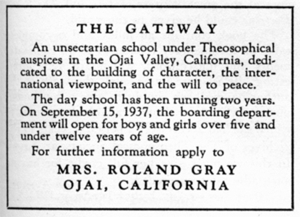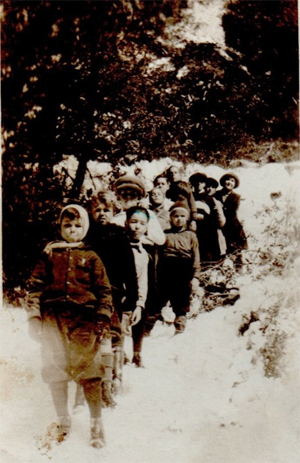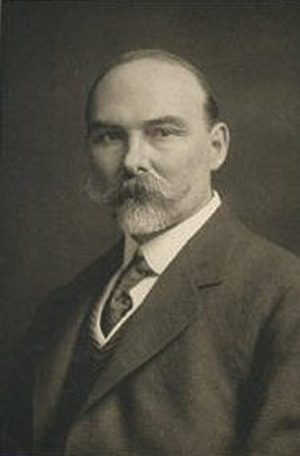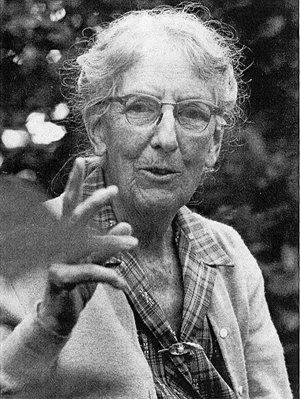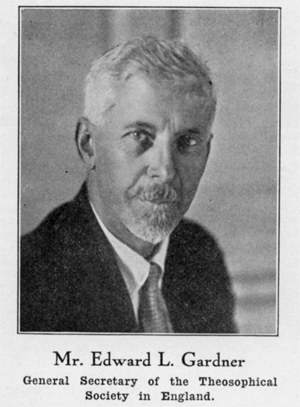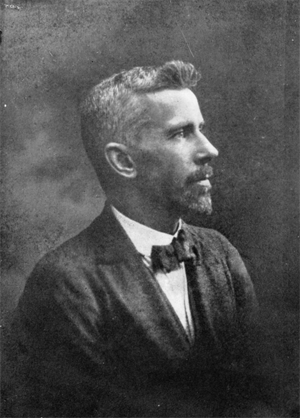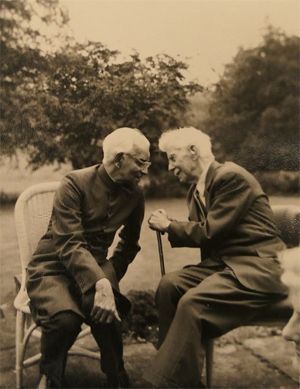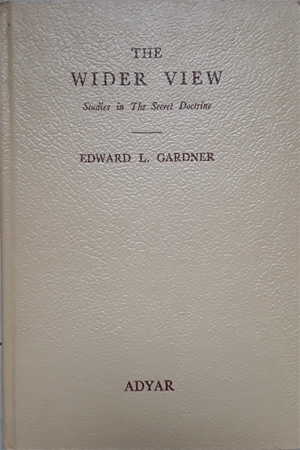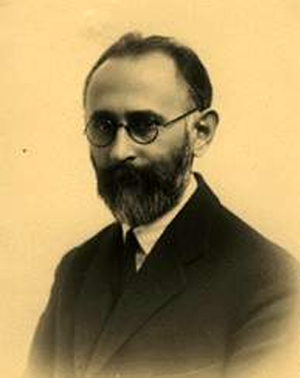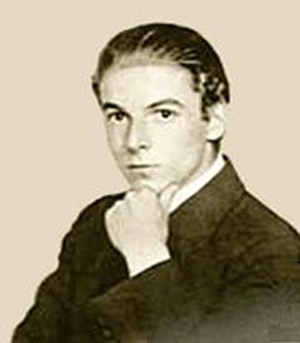Part 1 of 2
Jean Piagetby Wikipedia
Accessed: 8/16/19
NOTICE: THIS WORK MAY BE PROTECTED BY COPYRIGHTYOU ARE REQUIRED TO READ
THE COPYRIGHT NOTICE AT THIS LINK BEFORE YOU READ THE FOLLOWING WORK, THAT IS AVAILABLE SOLELY FOR PRIVATE STUDY, SCHOLARSHIP OR RESEARCH PURSUANT TO 17 U.S.C. SECTION 107 AND 108. IN THE EVENT THAT THE LIBRARY DETERMINES THAT UNLAWFUL COPYING OF THIS WORK HAS OCCURRED, THE LIBRARY HAS THE RIGHT TO BLOCK THE I.P. ADDRESS AT WHICH THE UNLAWFUL COPYING APPEARED TO HAVE OCCURRED. THANK YOU FOR RESPECTING THE RIGHTS OF COPYRIGHT OWNERS.
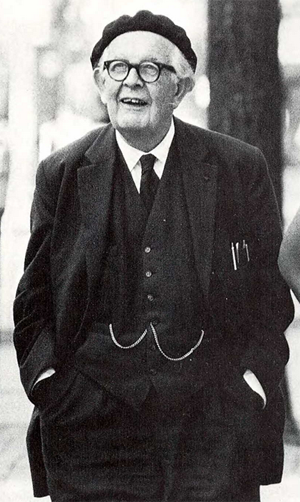
Jean Piaget
Piaget at the University of Michigan, c. 1968
Born Jean William Fritz Piaget
9 August 1896
Neuchâtel, Switzerland
Died 16 September 1980 (aged 84)
Geneva, Switzerland
Alma mater University of Neuchâtel
Known for Constructivism, Genevan School, genetic epistemology, theory of cognitive development, object permanence, egocentrism
Scientific career
Fields Developmental psychology, epistemology
Influences Immanuel Kant, Henri Bergson,[1] Pierre Janet, Alfred Binet, Théodore Simon, Sabina Spielrein, James Mark Baldwin[2]
Influenced Rabbi Shlomo Wolbe, Bärbel Inhelder,[3][4] Jerome Bruner,[5] Kenneth Kaye,[citation needed] Lawrence Kohlberg,[6] Robert Kegan,[7] Howard Gardner,[8] Thomas Kuhn,[9] Seymour Papert,[10] Lev Vygotsky,[11][12] Jordan Peterson, John Flavell, Yann LeCun[13]
Jean Piaget (UK: /piˈæʒeɪ/,[14][15] US: /ˌpiːəˈʒeɪ, pjɑːˈʒeɪ/,[14][16][17][18] French: [ʒɑ̃ pjaʒɛ]; 9 August 1896 – 16 September 1980) was a Swiss psychologist known for his work on child development. Piaget's theory of cognitive development and epistemological view are together called "genetic epistemology".
Piaget placed great importance on the education of children. As the Director of the International Bureau of Education, he declared in 1934 that "only education is capable of saving our societies from possible collapse, whether violent, or gradual."[19] His theory of child development is studied in pre-service education programs. Educators continue to incorporate constructivist-based strategies.
Piaget created the International Center for Genetic Epistemology in Geneva in 1955 while on the faculty of the University of Geneva and directed the Center until his death in 1980.[20] The number of collaborations that its founding made possible, and their impact, ultimately led to the Center being referred to in the scholarly literature as "Piaget's factory".[21]
According to Ernst von Glasersfeld, Jean Piaget was "the great pioneer of the constructivist theory of knowing."[22] However, his ideas did not become widely popularized until the 1960s.[23] This then led to the emergence of the study of development as a major sub-discipline in psychology.[24] By the end of the 20th century, Piaget was second only to B. F. Skinner as the most cited psychologist of that era.[25]
Personal lifePiaget was born in 1896 in Neuchâtel, in the Francophone region of Switzerland. He was the oldest son of Arthur Piaget (Swiss), a professor of medieval literature at the University of Neuchâtel, and Rebecca Jackson (French). Piaget was a precocious child who developed an interest in biology and the natural world. His early interest in zoology earned him a reputation among those in the field after he had published several articles on mollusks by the age of 15.[26] When he was 15, his former nanny wrote to his parents to apologize for having once lied to them about fighting off a would-be kidnapper from baby Jean's pram. There never was a kidnapper. Piaget became fascinated that he had somehow formed a memory of this kidnapping incident, a memory that endured even after he understood it to be false.[27]
He developed an interest in epistemology due to his godfather's urgings to study the fields of philosophy and logic.[28] He was educated at the University of Neuchâtel, and studied briefly at the University of Zürich. During this time, he published two philosophical papers that showed the direction of his thinking at the time, but which he later dismissed as adolescent thought.[29] His interest in psychoanalysis, at the time a burgeoning strain of psychology, can also be dated to this period. Piaget moved from Switzerland to Paris, France after his graduation and he taught at the Grange-Aux-Belles Street School for Boys. The school was run by Alfred Binet, the developer of the Binet-Simon test (later revised by Lewis Terman to become the Stanford–Binet Intelligence Scales). Piaget assisted in the marking of Binet's intelligence tests. It was while he was helping to mark some of these tests that Piaget noticed that young children consistently gave wrong answers to certain questions. Piaget did not focus so much on the fact of the children's answers being wrong, but that young children consistently made types of mistakes that older children and adults did not. This led him to the theory that young children's cognitive processes are inherently different from those of adults. Ultimately, he was to propose a global theory of cognitive developmental stages in which individuals exhibit certain common patterns of cognition in each period of development. In 1921, Piaget returned to Switzerland as director of the Rousseau Institute in Geneva. At this time, the institute was directed by Édouard Claparède.[30] Piaget was familiar with many of Claparède's ideas including that of the psychological concept 'groping' which was closely associated with "trials and errors" observed in human mental patterns.[31]
In 1923, he married Valentine Châtenay (7 January 1899 – 3 July 1983)[32] the couple had three children, whom Piaget studied from infancy. From 1925 to 1929, Piaget worked as a professor of psychology, sociology, and the philosophy of science at the University of Neuchatel.[33] In 1929, Jean Piaget accepted the post of Director of the International Bureau of Education and remained the head of this international organization until 1968. Every year, he drafted his "Director's Speeches" for the IBE Council and for the International Conference on Public Education in which he explicitly addressed his educational credo.
Having taught at the University of Geneva and at the University of Paris, in 1964, Piaget was invited to serve as chief consultant at two conferences at Cornell University (March 11–13) and University of California, Berkeley (March 16–18). The conferences addressed the relationship of cognitive studies and curriculum development and strived to conceive implications of recent investigations of children's cognitive development for curricula.[34]
In 1979 he was awarded the Balzan Prize for Social and Political Sciences. He died in 1980 and was buried with his family in an unmarked grave in the Cimetière des Rois (Cemetery of Kings) in Geneva. This was as per his request.[35]
Career history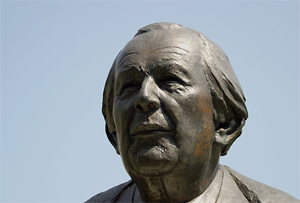 Bust of Jean Piaget in the Parc des Bastions, Geneva
Bust of Jean Piaget in the Parc des Bastions, GenevaHarry Beilin described Jean Piaget's theoretical research program[36] as consisting of four phases:
1. the sociological model of development,
2. the biological model of intellectual development,
3. the elaboration of the logical model of intellectual development,
4. the study of figurative thought.
The resulting theoretical frameworks are sufficiently different from each other that they have been characterized as representing different "Piagets." More recently, Jeremy Burman responded to Beilin and called for the addition of a phase before his turn to psychology: "the zeroeth Piaget."[37]
Piaget before psychologyBefore Piaget became a psychologist, he trained in natural history and philosophy. He received a doctorate in 1918 from the University of Neuchâtel. He then undertook post-doctoral training in Zürich (1918–1919), and Paris (1919–1921). He was hired by Théodore Simon to standardize psychometric measures for use with French children in 1919.[38] The theorist we recognize today only emerged when he moved to Geneva, to work for Édouard Claparède as director of research at the Rousseau Institute, in 1922.
Sociological model of developmentPiaget first developed as a psychologist in the 1920s. He investigated the hidden side of children's minds. Piaget proposed that children moved from a position of egocentrism to sociocentrism. For this explanation he combined the use of psychological and clinical methods to create what he called a semiclinical interview. He began the interview by asking children standardized questions and depending on how they answered, he would ask them a series of nonstandard questions. Piaget was looking for what he called "spontaneous conviction" so he often asked questions the children neither expected nor anticipated. In his studies, he noticed there was a gradual progression from intuitive to scientific and socially acceptable responses. Piaget theorized children did this because of the social interaction and the challenge to younger children's ideas by the ideas of those children who were more advanced.
This work was used by Elton Mayo as the basis for the famous Hawthorne Experiments.[39][40] For Piaget, it also led to an honorary doctorate from Harvard in 1936.[41]
Biological model of intellectual developmentIn this stage, Piaget believed that the process of thinking and the intellectual development could be regarded as an extension of the biological process of the adaptation of the species, which has also two on-going processes: assimilation and accommodation. There is assimilation when a child responds to a new event in a way that is consistent with an existing schema.[42] There is accommodation when a child either modifies an existing schema or forms an entirely new schema to deal with a new object or event.[42]
He argued infants were engaging in an act of assimilation when they sucked on everything in their reach. He claimed infants transform all objects into an object to be sucked. The children were assimilating the objects to conform to their own mental structures. Piaget then made the assumption that whenever one transforms the world to meet individual needs or conceptions, one is, in a way, assimilating it. Piaget also observed his children not only assimilating objects to fit their needs, but also modifying some of their mental structures to meet the demands of the environment. This is the second division of adaptation known as accommodation. To start out, the infants only engaged in primarily reflex actions such as sucking, but not long after, they would pick up objects and put them in their mouths. When they do this, they modify their reflex response to accommodate the external objects into reflex actions. Because the two are often in conflict, they provide the impetus for intellectual development. The constant need to balance the two triggers intellectual growth.
To test his theory, Piaget observed the habits in his own children.
Elaboration of the logical model of intellectual developmentIn the model Piaget developed in stage three, he argued that intelligence develops in a series of stages that are related to age and are progressive because one stage must be accomplished before the next can occur. For each stage of development the child forms a view of reality for that age period. At the next stage, the child must keep up with earlier level of mental abilities to reconstruct concepts. Piaget conceived intellectual development as an upward expanding spiral in which children must constantly reconstruct the ideas formed at earlier levels with new, higher order concepts acquired at the next level.
It is primarily the "Third Piaget" (the logical model of intellectual development) that was debated by American psychologists when Piaget's ideas were "rediscovered" in the 1960s.[43]
Study of figurative thoughtPiaget studied areas of intelligence like perception and memory that are not entirely logical. Logical concepts are described as being completely reversible because they can always get back to the starting point, meaning that if one starts with a given premise and follows logical steps to reach a conclusion, the same steps may be done in the opposite order, starting from the conclusion to arrive at the premise. The perceptual concepts Piaget studied could not be manipulated. To describe the figurative process, Piaget uses pictures as examples. Pictures cannot be separated because contours cannot be separated from the forms they outline. Memory is the same way: it is never completely reversible; people cannot necessarily recall all the intervening events between two points. During this last period of work, Piaget and his colleague Inhelder also published books on perception, memory, and other figurative processes such as learning.[44][45]
Because Piaget's theory is based upon biological maturation and stages, the notion of readiness is important. Readiness concerns when certain information or concepts should be taught. According to Piaget's theory, children should not be taught certain concepts until they reached the appropriate stage of cognitive development.[46] For example, young children in the preoperational stage engage in "irreversible" thought and cannot comprehend that an item that has been transformed in some way may be returned to its original state.[47]
TheoryMain article: Piaget's theory of cognitive development
Piaget defined himself as a 'genetic' epistemologist, interested in the process of the qualitative development of knowledge. He considered cognitive structures development as a differentiation of biological regulations. When his entire theory first became known – the theory in itself being based on a structuralist and a cognitivitist approach – it was an outstanding and exciting development in regards to the psychological community at that time.[48]
There are a total of four phases in Piaget's research program that included books on certain topics of developmental psychology. In particular, during one period of research, he described himself studying his own three children, and carefully observing and interpreting their cognitive development.[49] In one of his last books, Equilibration of Cognitive Structures: The Central Problem of Intellectual Development, he intends to explain knowledge development as a process of equilibration using two main concepts in his theory, assimilation and accommodation, as belonging not only to biological interactions but also to cognitive ones.
Piaget believed answers for the epistemological questions at his time could be answered, or better proposed, if one looked to the genetic aspect of it, hence his experimentations with children and adolescents. As he says in the introduction of his book Genetic Epistemology: "What the genetic epistemology proposes is discovering the roots of the different varieties of knowledge, since its elementary forms, following to the next levels, including also the scientific knowledge."
StagesThe four development stages are described in Piaget's theory as:
1. Sensorimotor stage: from birth to age two. The children experience the world through movement and their senses. During the sensorimotor stage children are extremely egocentric, meaning they cannot perceive the world from others' viewpoints. The sensorimotor stage is divided into six substages:[50]
I. Simple reflexes;
From birth to one month old. At this time infants use reflexes such as rooting and sucking.
II. First habits and primary circular reactions;
From one month to four months old. During this time infants learn to coordinate sensation and two types of schema (habit and circular reactions). A primary circular reaction is when the infant tries to reproduce an event that happened by accident (ex.: sucking thumb).
III. Secondary circular reactions;
From four to eight months old. At this time they become aware of things beyond their own body; they are more object-oriented. At this time they might accidentally shake a rattle and continue to do it for sake of satisfaction.
IV. Coordination of secondary circular reactions;
From eight months to twelve months old. During this stage they can do things intentionally. They can now combine and recombine schemata and try to reach a goal (ex.: use a stick to reach something). They also begin to understand object permanence in the later months and early into the next stage. That is, they understand that objects continue to exist even when they can't see them.
V. Tertiary circular reactions, novelty, and curiosity;
From twelve months old to eighteen months old. During this stage infants explore new possibilities of objects; they try different things to get different results.
VI. Internalization of schemata.
Some followers of Piaget's studies of infancy, such as Kenneth Kaye[51] argue that his contribution was as an observer of countless phenomena not previously described, but that he didn't offer explanation of the processes in real time that cause those developments, beyond analogizing them to broad concepts about biological adaptation generally. Kaye's "apprenticeship theory" of cognitive and social development refuted Piaget's assumption that mind developed endogenously in infants until the capacity for symbolic reasoning allowed them to learn language.
2. Preoperational stage: Piaget's second stage, the pre-operational stage, starts when the child begins to learn to speak at age two and lasts up until the age of seven. During the pre-operational Stage of cognitive development, Piaget noted that children do not yet understand concrete logic and cannot mentally manipulate information. Children's increase in playing and pretending takes place in this stage. However, the child still has trouble seeing things from different points of view. The children's play is mainly categorized by symbolic play and manipulating symbols. Such play is demonstrated by the idea of checkers being snacks, pieces of paper being plates, and a box being a table. Their observations of symbols exemplifies the idea of play with the absence of the actual objects involved. By observing sequences of play, Piaget was able to demonstrate that, towards the end of the second year, a qualitatively new kind of psychological functioning occurs, known as the Pre-operational Stage.[52]
The pre-operational stage is sparse and logically inadequate in regard to mental operations. The child is able to form stable concepts as well as magical beliefs. The child, however, is still not able to perform operations, which are tasks that the child can do mentally, rather than physically. Thinking in this stage is still egocentric, meaning the child has difficulty seeing the viewpoint of others. The Pre-operational Stage is split into two substages: the symbolic function substage, and the intuitive thought substage. The symbolic function substage is when children are able to understand, represent, remember, and picture objects in their mind without having the object in front of them. The intuitive thought substage is when children tend to propose the questions of "why?" and "how come?" This stage is when children want the knowledge of knowing everything.[52]
The Preoperational Stage is divided into two substages:
I. Symbolic Function Substage
From two to four years of age children find themselves using symbols to represent physical models of the world around them. This is demonstrated through a child's drawing of their family in which people are not drawn to scale or accurate physical traits are given. The child knows they are not accurate but it does not seem to be an issue to them.
II. Intuitive Thought Substage
At between about the ages of four and seven, children tend to become very curious and ask many questions, beginning the use of primitive reasoning. There is an emergence in the interest of reasoning and wanting to know why things are the way they are. Piaget called it the "intuitive substage" because children realize they have a vast amount of knowledge, but they are unaware of how they acquired it. Centration, conservation, irreversibility, class inclusion, and transitive inference are all characteristics of preoperative thought.[52]
3. Concrete operational stage: from ages seven to eleven. Children can now conserve and think logically (they understand reversibility) but are limited to what they can physically manipulate. They are no longer egocentric. During this stage, children become more aware of logic and conservation, topics previously foreign to them. Children also improve drastically with their classification skills
4. Formal operational stage: from age eleven to sixteen and onwards (development of abstract reasoning). Children develop abstract thought and can easily conserve and think logically in their mind. Abstract thought is newly present during this stage of development. Children are now able to think abstractly and utilize metacognition. Along with this, the children in the formal operational stage display more skills oriented towards problem solving, often in multiple steps.
Developmental processPiaget provided no concise description of the development process as a whole. Broadly speaking it consisted of a cycle:
• The child performs an action which has an effect on or organizes objects, and the child is able to note the characteristics of the action and its effects.
• Through repeated actions, perhaps with variations or in different contexts or on different kinds of objects, the child is able to differentiate and integrate its elements and effects. This is the process of "reflecting abstraction" (described in detail in Piaget 2001).
• At the same time, the child is able to identify the properties of objects by the way different kinds of action affect them. This is the process of "empirical abstraction".
• By repeating this process across a wide range of objects and actions, the child establishes a new level of knowledge and insight. This is the process of forming a new "cognitive stage". This dual process allows the child to construct new ways of dealing with objects and new knowledge about objects themselves.
• However, once the child has constructed these new kinds of knowledge, he or she starts to use them to create still more complex objects and to carry out still more complex actions. As a result, the child starts to recognize still more complex patterns and to construct still more complex objects. Thus a new stage begins, which will only be completed when all the child's activity and experience have been re-organized on this still higher level.
This process may not be wholly gradual, but new evidence shows that the passage into new stages is more gradual than once thought. Once a new level of organization, knowledge and insight proves to be effective, it will quickly be generalized to other areas if they exist. As a result, transitions between stages can seem to be rapid and radical, but oftentimes the child has grasped one aspect of the new stage of cognitive functioning but not addressed others. The bulk of the time spent in a new stage consists of refining this new cognitive level; however it does not always happen quickly. For example, a child may see that two different colors of Play-Doh have been fused together to make one ball, based on the color. However, if sugar is mixed into water or iced tea, then the sugar "disappeared" and therefore does not exist to the child at that stage. These levels of one concept of cognitive development are not realized all at once, giving us a gradual realization of the world around us.[53]
It is because this process takes this dialectical form, in which each new stage is created through the further differentiation, integration, and synthesis of new structures out of the old, that the sequence of cognitive stages are logically necessary rather than simply empirically correct. Each new stage emerges only because the child can take for granted the achievements of its predecessors, and yet there are still more sophisticated forms of knowledge and action that are capable of being developed.
Because it covers both how we gain knowledge about objects and our reflections on our own actions, Piaget's model of development explains a number of features of human knowledge that had never previously been accounted for. For example, by showing how children progressively enrich their understanding of things by acting on and reflecting on the effects of their own previous knowledge, they are able to organize their knowledge in increasingly complex structures. Thus, once a young child can consistently and accurately recognize different kinds of animals, he or she then acquires the ability to organize the different kinds into higher groupings such as "birds", "fish", and so on. This is significant because they are now able to know things about a new animal simply on the basis of the fact that it is a bird – for example, that it will lay eggs.
At the same time, by reflecting on their own actions, the child develops an increasingly sophisticated awareness of the "rules" that govern in various ways. For example, it is by this route that Piaget explains this child's growing awareness of notions such as "right", "valid", "necessary", "proper", and so on. In other words, it is through the process of objectification, reflection and abstraction that the child constructs the principles on which action is not only effective or correct but also justified.
One of Piaget's most famous studies focused purely on the discriminative abilities of children between the ages of two and a half years old, and four and a half years old. He began the study by taking children of different ages and placing two lines of sweets, one with the sweets in a line spread further apart, and one with the same number of sweets in a line placed more closely together. He found that, "Children between 2 years, 6 months old and 3 years, 2 months old correctly discriminate the relative number of objects in two rows; between 3 years, 2 months and 4 years, 6 months they indicate a longer row with fewer objects to have "more"; after 4 years, 6 months they again discriminate correctly" (Cognitive Capacity of Very Young Children, p. 141). Initially younger children were not studied, because if at four years old a child could not conserve quantity, then a younger child presumably could not either. The results show however that children that are younger than three years and two months have quantity conservation, but as they get older they lose this quality, and do not recover it until four and a half years old. This attribute may be lost due to a temporary inability to solve because of an overdependence on perceptual strategies, which correlates more candy with a longer line of candy, or due to the inability for a four-year-old to reverse situations.
By the end of this experiment several results were found. First, younger children have a discriminative ability that shows the logical capacity for cognitive operations exists earlier than acknowledged. This study also reveals that young children can be equipped with certain qualities for cognitive operations, depending on how logical the structure of the task is. Research also shows that children develop explicit understanding at age 5 and as a result, the child will count the sweets to decide which has more. Finally the study found that overall quantity conservation is not a basic characteristic of humans' native inheritance.
Genetic epistemologyAccording to Jean Piaget, genetic epistemology attempts to "explain knowledge, and in particular scientific knowledge, on the basis of its history, its sociogenesis, and especially the psychological origins of the notions and operations upon which it is based". Piaget believed he could test epistemological questions by studying the development of thought and action in children. As a result, Piaget created a field known as genetic epistemology with its own methods and problems. He defined this field as the study of child development as a means of answering epistemological questions.
SchemaA Schema is a structured cluster of concepts, it can be used to represent objects, scenarios or sequences of events or relations. The original idea was proposed by philosopher Immanuel Kant as innate structures used to help us perceive the world.[54]
A schema (pl. schemata) is the mental framework that is created as children interact with their physical and social environments.[55] For example, many 3-year-olds insist that the sun is alive because it comes up in the morning and goes down at night. According to Piaget, these children are operating based on a simple cognitive schema that things that move are alive. At any age, children rely on their current cognitive structures to understand the world around them. Moreover, younger and older children may often interpret and respond to the same objects and events in very different ways because cognitive structures take different forms at different ages.[56]
Piaget (1953) described three kinds of intellectual structures: behavioural (or sensorimotor) schemata, symbolic schemata, and operational schemata.
• Behavioural schemata: organized patterns of behaviour that are used to represent and respond to objects and experiences.
• Symbolic schemata: internal mental symbols (such as images or verbal codes) that one uses to represent aspects of experience.
• Operational schemata: internal mental activity that one performs on objects of thought.[57]
According to Piaget, children use the process of assimilation and accommodation to create a schema or mental framework for how they perceive and/or interpret what they are experiencing. As a result, the early concepts of young children tend to be more global or general in nature.[58]
Similarly, Gallagher and Reid (1981) maintained that adults view children's concepts as highly generalized and even inaccurate. With added experience, interactions, and maturity, these concepts become refined and more detailed. Overall, making sense of the world from a child's perspective is a very complex and time-consuming process.[59]
Schemata are:
• Critically important building block of conceptual development
• Constantly in the process of being modified or changed
• Modified by on-going experiences
• A generalized idea, usually based on experience or prior knowledge.[58]
These schemata are constantly being revised and elaborated upon each time the child encounters new experiences. In doing this children create their own unique understanding of the world, interpret their own experiences and knowledge, and subsequently use this knowledge to solve more complex problems. In a neurological sense, the brain/mind is constantly working to build and rebuild itself as it takes in, adapts/modifies new information, and enhances understanding.[58]
Physical microstructure of schemataIn his Biology and Knowledge (1967+ / French 1965), Piaget tentatively hinted at possible physical embodiments for his abstract schema entities. At the time, there was much talk and research about RNA as such an agent of learning, and Piaget considered some of the evidence. However, he did not offer any firm conclusions, and confessed that this was beyond his area of expertise.
One difficulty at that time was that it was generally assumed that nearly all RNA served as mere templates for protein production, and such ideas offered no coherent explanation for Piaget's schema account. However (from 2001 onward), Mattick[60] [2] and others pointed out that, in humans, only about 3% of RNA serves that purpose! — leaving ample stocks of ncRNA available for other tasks (perhaps acting in their own right, rather than as templates). On that new basis, it has now been possible to reverse engineer a seemingly plausible mechanistic framework, based on Piaget's work, accounting for some of the activities of the hippocampus and cerebral cortex etc.[61] Meanwhile it remains to be seen whether this will be consistent with new direct experimental evidence (if indeed such experiments are possible).
Research methodsPiaget wanted to revolutionize the way research was conducted. Although he started researching with his colleagues using a traditional method of data collection, he was not fully satisfied with the results and wanted to keep trying to find new ways of researching using a combination of data, which included naturalistic observation, psychometrics, and the psychiatric clinical examination, in order to have a less guided form of research that would produce more empirically valid results. As Piaget developed new research methods, he wrote a book called The Language and Thought of the Child, which aimed to synthesize the methods he was using in order to study the conclusion children drew from situations and how they arrived to such conclusion. The main idea was to observe how children responded and articulated certain situations with their own reasoning, in order to examine their thought processes (Mayer, 2005).
Piaget administered a test in 15 boys with ages ranging from 10 to 14 years in which he asked participants to describe the relationship between a mixed bouquet of flowers and a bouquet with flowers of the same color. The purpose of this study was to analyze the thinking process the boys had and to draw conclusions about the logic processes they had used, which was a psychometric technique of research. Piaget also used the psychoanalytic method initially developed by Sigmund Freud. The purpose of using such method was to examine the unconscious mind, as well as to continue parallel studies using different research methods. Psychoanalysis was later rejected by Piaget, as he thought it was insufficiently empirical (Mayer, 2005).
Piaget argued that children and adults used speech for different purposes. In order to confirm his argument, he experimented analyzing a child's interpretation of a story. In the experiment, the child listened to a story and then told a friend that same story in his/her/their own words. The purpose of this study was to examine how children verbalize and understand each other without adult intervention. Piaget wanted to examine the limits of naturalistic observation, in order to understand a child's reasoning. He realized the difficulty of studying children's thoughts, as it is hard to know if a child is pretending to believe their thoughts or not. Piaget was the pioneer researcher to examine children's conversations in a social context – starting from examining their speech and actions – where children were comfortable and spontaneous (Kose, 1987).
Issues and possible solutionsAfter conducting many studies, Piaget was able to find significant differences in the way adults and children reason; however, he was still unable to find the path of logic reasoning and the unspoken thoughts children had, which could allow him to study a child's intellectual development over time (Mayer, 2005). In his third book, The Child's Conception of the World, Piaget recognized the difficulties of his prior techniques and the importance of psychiatric clinical examination. The researcher believed that the way clinical examinations were conducted influenced how a child's inner realities surfaced. Children would likely respond according to the way the research is conducted, the questions asked, or the familiarity they have with the environment. The clinical examination conducted for his third book provides a thorough investigation into a child's thinking process. An example of a question used to research such process was: "Can you see a thought?" (Mayer, 2005, p. 372).
Development of new methodsPiaget recognized that psychometric tests had its limitations, as children were not able to provide the researcher with their deepest thoughts and inner intellect. It was also difficult to know if the results of child examination reflected what children believed or if it is just a pretend situation. For example, it is very difficult to know with certainty if a child who has a conversation with a toy believes the toy is alive or if the child is just pretending. Soon after drawing conclusions about psychometric studies, Piaget started developing the clinical method of examination. The clinical method included questioning a child and carefully examining their responses – in order to observe how the child reasoned according to the questions asked – and then examining the child's perception of the world through their responses. Piaget recognized the difficulties of interviewing a child and the importance of recognizing the difference between "liberated" versus "spontaneous" responses (Mayer, 2005, p. 372).
Criticism of Piaget's research methods"The developmental theory of Jean Piaget has been criticized on the grounds that it is conceptually limited, empirically false, or philosophically and epistemologically untenable." Piaget responded to criticism by contending that the vast majority of critics did not understand the outcomes he wished to obtain from his research.[62]
As Piaget believed development was a universal process, his initial sample sizes were inadequate, particularly in the formulation of his theory of infant development.[63] Piaget's theories of infant development were based on his observations of his own three children. While this clearly presents problems with the sample size, Piaget also probably introduced confounding variables and social desirability into his observations and his conclusions based on his observations. It is entirely possible Piaget conditioned his children to respond in a desirable manner, so, rather than having an understanding of object permanence, his children might have learned to behave in a manner that indicated they understood object permanence. The sample was also very homogenous, as all three children had a similar genetic heritage and environment. Piaget did, however, have larger sample sizes during his later years.
Development of research methodsPiaget wanted to research in environments that would allow children to connect with some existing aspects of the world. The idea was to change the approach described in his book The Child's Conception of the World and move away from the vague questioning interviews. This new approach was described in his book The Child's Conception of Physical Causality, where children were presented with dilemmas and had to think of possible solutions on their own. Later, after carefully analyzing previous methods, Piaget developed a combination of naturalistic observation with clinical interviewing in his book Judgment and Reasoning in the Child, where a child's intellect was tested with questions and close monitoring. Piaget was convinced he had found a way to analyze and access a child's thoughts about the world in a very effective way (Mayer, 2005). Piaget's research provided a combination of theoretical and practical research methods and it has offered a crucial contribution to the field of developmental psychology (Beilin, 1992). "Piaget is often criticized because his method of investigation, though somewhat modified in recent years, is still largely clinical". He observes a child's surroundings and behavior. He then comes up with a hypothesis testing it and focusing on both the surroundings and behavior after changing a little of the surrounding.[64]
Influence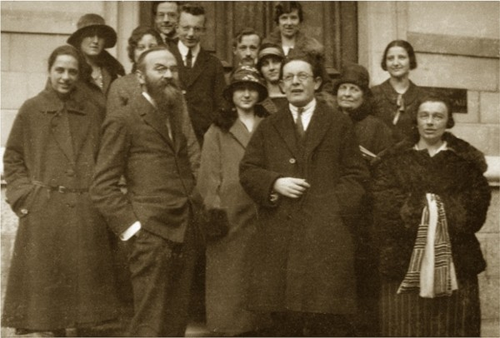 Photo of the Jean Piaget Foundation with Pierre Bovet (1878–1965) first row (with large beard) and Jean Piaget (1896–1980) first row (on the right, with glasses) in front of the Rousseau Institute (Geneva), 1925
Photo of the Jean Piaget Foundation with Pierre Bovet (1878–1965) first row (with large beard) and Jean Piaget (1896–1980) first row (on the right, with glasses) in front of the Rousseau Institute (Geneva), 1925Despite his ceasing to be a fashionable psychologist, the magnitude of Piaget's continuing influence can be measured by the global scale and activity of the Jean Piaget Society, which holds annual conferences and attracts around 700 participants.[65] His theory of cognitive development has proved influential in many different areas:
• Developmental psychology
• Education and Morality
• Historical studies of thought and cognition
• Evolution
• Philosophy
• Primatology
• Artificial intelligence (AI)
Developmental psychologyPiaget is the most influential developmental psychologist to date,[62] influencing not only the work of Lev Vygotsky and of Lawrence Kohlberg but whole generations of eminent academics.[clarification needed] Although subjecting his ideas to massive scrutiny led to innumerable improvements and qualifications of his original model and the emergence of a plethora of neo-Piagetian and post-Piagetian variants, Piaget's original model has proved to be remarkably robust.[62]
Piaget on educationBy using Piaget's theory, educators focus on their students as learners. As a result of this focus, education is learner-center and constructivist-based to an extent. Piaget's theory allows teachers to view students as individual learners who add new concepts to prior knowledge to construct, or build, understanding for themselves.[66] Teachers who use a learner-centered approach as a basis for their professional practices incorporate the several dispositions.[66] They provide experience-based educational opportunities. These teachers also contemplate the learners’ individual qualities and attitudes during curriculum planning. Educators allow learners’ insights to alter the curriculum. They nourish and support learners’ curiosity. They also involve learners’ emotions and create a learning environment in which students feel safe.[66]
There are two differences between the preoperational and concrete operational stages that apply to education. These differences are reversibility and decentration. At times, reversibility and decentration occur at the same time.[67] When students think about the steps to complete a task without using a particular logical, sequential order, they are using reversibility.[67] Decentration allows them to concentrate on multiple components of a problematic task at a time.[67] Students use both reversibility and decentration to function throughout the school day, follow directions, and complete assignments.
An example of a student using reversibility is when learning new vocabulary. The student creates a list of unfamiliar words from a literary text. Then, he researches the definition of those words before asking classmate to test him. His teacher has given a set of particular instructions that he must follow in a particular order: he must write the word before defining it, and complete these two steps repeatedly.[67] A child in the preoperational stage gets confused during this process and needs assistance from the teacher to stay on task. The teacher refers him back to his text in order to notate the next word before he can define it.[67] A child in the preoperational stage does not understand the organization required to complete this assignment. However, a child in the concrete operational stage understands the organization, and he can recall the steps in any order while being able to follow the order given.[67] Using decentration, the child has the two activities on his mind: identify words and find them in the dictionary.[67]
A sample of decentration is a preschooler may use a toy banana as a pretend telephone. The child knows the difference between the fruit and a phone. However, in this form of play, he is operating on two levels at once.[67] In an older child at the concrete operational level, decentration allows him to complete subtraction of two-digit numbers and indicate which of the problems also involved borrowing from the other column. The student simultaneously does both.[67] Using reversibility, the student has to move mentally between two subtasks.
Regarding the giving of praise by teachers, praise is a reinforcer for students. Adolescents undergo social-emotional development such that they seek rapport with peers. Thus, teacher praise is not as powerful for students who see teachers as authority figures. They give no value to praise provided by adults, or they have no respect for the individual who is giving praise.[68]
EducationDuring the 1970s and 1980s, Piaget's works also inspired the transformation of European and American education, including both theory and practice, leading to a more ‘child-centered’ approach. In Conversations with Jean Piaget, he says: "Education, for most people, means trying to lead the child to resemble the typical adult of his society ... but for me and no one else, education means making creators... You have to make inventors, innovators—not conformists" (Bringuier, 1980, p. 132).
His theory of cognitive development can be used as a tool in the early childhood classroom. According to Piaget, children developed best in a classroom with interaction.
Piaget defined knowledge as the ability to modify, transform, and "operate on" an object or idea, such that it is understood by the operator through the process of transformation.[69] Learning, then, occurs as a result of experience, both physical and logical, with the objects themselves and how they are acted upon. Thus, knowledge must be assimilated in an active process by a learner with matured mental capacity, so that knowledge can build in complexity by scaffolded understanding. Understanding is scaffolded by the learner through the process of equilibration, whereby the learner balances new knowledge with previous understanding, thereby compensating for "transformation" of knowledge.[69]
Learning, then, can also be supported by instructors in an educational setting. Piaget specified that knowledge cannot truly be formed until the learner has matured the mental structures to which that learning is specific, and thereby development constrains learning. Nevertheless, knowledge can also be "built" by building on simpler operations and structures that have already been formed. Basing operations of an advanced structure on those of simpler structures thus scaffolds learning to build on operational abilities as they develop. Good teaching, then, is built around the operational abilities of the students such that they can excel in their operational stage and build on preexisting structures and abilities and thereby "build" learning.[69]
Evidence of the effectiveness of a contemporary curricular design building on Piaget's theories of developmental progression and the support of maturing mental structures can be seen in Griffin and Case's "Number Worlds" curriculum.[70] The curriculum works toward building a "central conceptual structure" of number sense in young children by building on five instructional processes, including aligning curriculum to the developmental sequencing of acquisition of specific skills. By outlining the developmental sequence of number sense, a conceptual structure is built and aligned to individual children as they develop.
